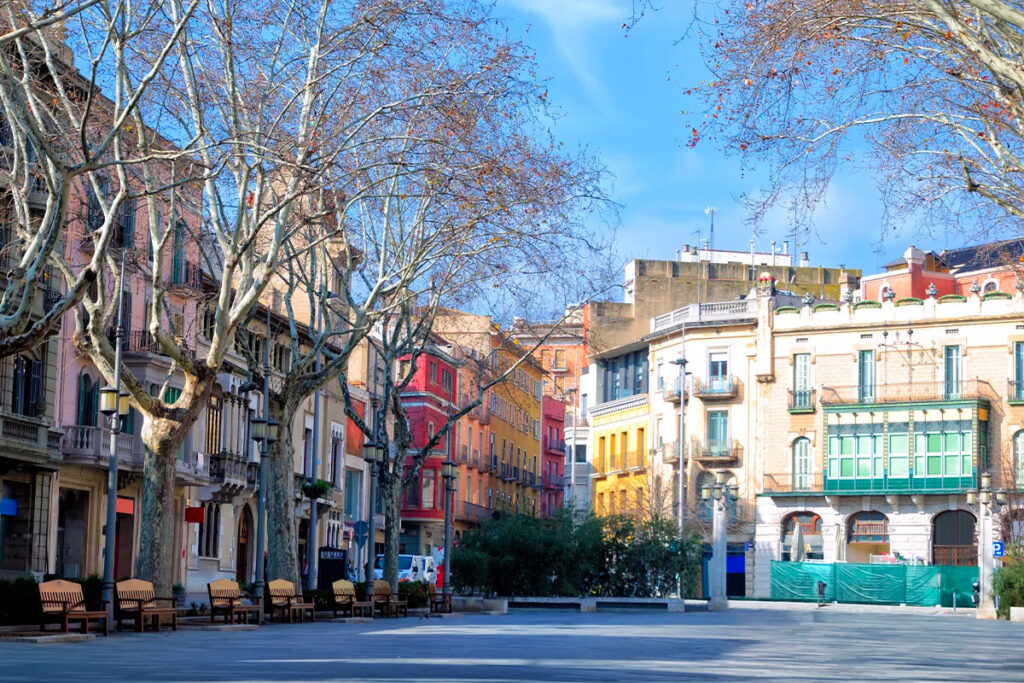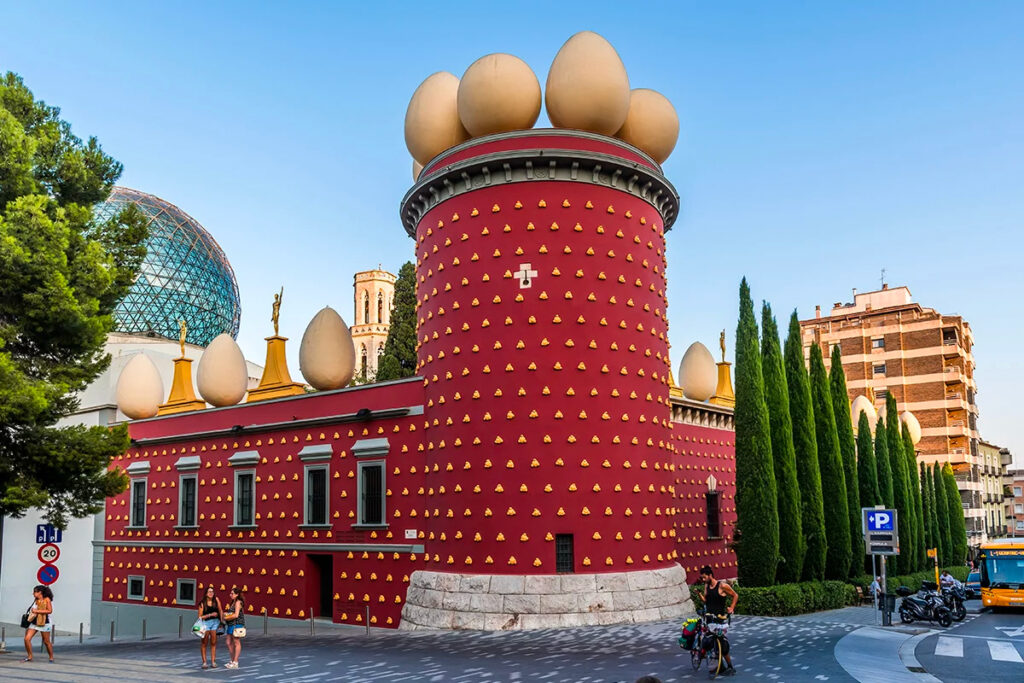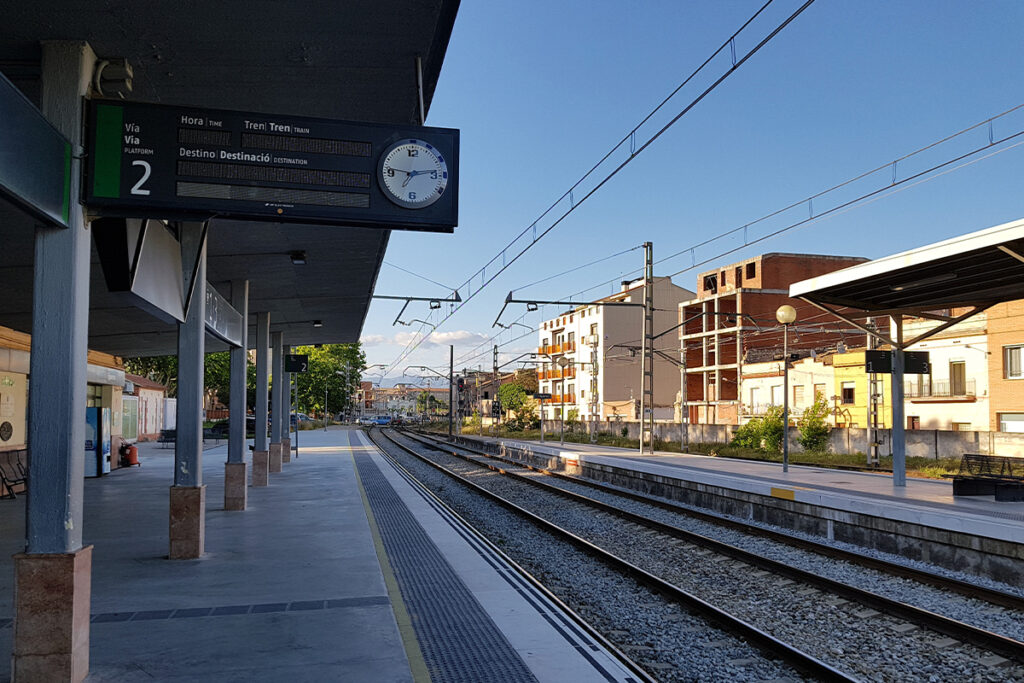Welcome to Figueres, a treasure trove of art, history, and culture in the heart of Catalonia!
This enchanting city is not only the birthplace of the world-famous surrealist artist Salvador Dalí but also home to an array of fascinating attractions and museums. So, are you ready to embark on an unforgettable journey through Figueres and uncover its splendors? Let’s dive in!
- Explore the surreal spaces of Dalí Theatre Museum & marvel at Europe’s largest fortress, Castell de Sant Ferran!
- Enjoy Figueres’ vibrant atmosphere and hidden gems along La Rambla with amazing landmarks and attractions!
- Discover Salvador Dali’s birthplace & combine it with a visit to his nearby museum for an unforgettable experience!
Discovering the Dalí Theatre Museum
Nestled in the charming streets of Figueres lies the Dalí Theatre Museum, a stunning tribute to the genius of Salvador Dalí and often considered the main attraction of the city.
Designed by the artist himself, this unique Dali Museum holds the title of the largest surrealist object in the world. The Theatre Museum houses an extensive collection of Dalí’s works, from captivating paintings and drawings to awe-inspiring three-dimensional installations and sculptures.
Venturing inside, you’ll be greeted by the mesmerizing Mae West Room, which features a mind-bending 3D installation of the actress’ face. As you delve deeper, don’t miss the Palace of the Wind, another fascinating exhibit created specifically for the museum. And, for a truly unique experience, pay your respects at Salvador Dalí’s final resting place, as the artist himself is buried within the museum’s walls.
Navigating the Surreal Spaces

The Dalí Theatre Museum, also known as the Dalí Museum, is a labyrinth of wonder, with each room offering a new surprise around every corner. As you make your way through this surreal space, you’ll encounter a diverse array of Dalí’s artistry, including works such as Port Alguer (1924), The Spectre of Sex-Appeal (1932), The Cosmic Athletes (1943), Dawn, Noon, Afternoon, and Evening (1979).
To fully immerse yourself in the museum’s unique atmosphere, be sure to explore the Mae West Room and the Palace of the Wind, both of which were created specifically for the museum by Dalí himself. And, as you wander through these incredible spaces, take a moment to appreciate the rich history and artistry on display, from the museum’s origins as an old theatre to the countless masterpieces housed within its walls.
Tips for a Memorable Visit
Planning ahead can help you maximize your visit to the Dalí Theatre Museum. To avoid the crowds, arrive around 1:30 PM, just before the Spaniards have lunch. If you haven’t booked your ticket in advance, be prepared to wait in line, but don’t worry – you can take turns saving your place in line and exploring the surrounding area. Allocate at least two hours to fully explore the museum, and don’t forget to take advantage of the amazing discount offered at the Toy Museum of Catalonia with your Dalí Theatre Museum ticket – a whopping 30% off the entrance fee!
The Historic Castell de Sant Ferran

Perched on a hill overlooking Figueres stands the impressive Castell de Sant Ferran, a testament to the city’s rich history. Dating back to the 18th century, this colossal fortress is the largest of its kind in Europe and boasts an array of fascinating features, including underground stables, a vast network of outer walls, and subterranean cisterns.
As you explore the historic Castell de Sant Ferran, also known as Sant Ferran Castle, you’ll be transported back in time, walking the same paths that once housed thousands of soldiers and their horses. And, with its commanding views of the surrounding countryside and the sparkling Mediterranean Sea, the castle offers a truly unforgettable experience for history buffs and casual visitors alike.
A Self-Guided Tour Experience
Embarking on a self-guided tour of the Castell de Sant Ferran allows you to fully appreciate the fortress’s grandeur at your own pace. Follow a walking route around the castle, exploring the barracks, the parade square, the officers’ quarters and the military chapel.
As you navigate the fortress’s vast expanse, be sure to take in the impressive architectural details, from its sloping walls designed to deflect cannon fire to the awe-inspiring subterranean cisterns capable of storing millions of liters of water.
Before setting off on your tour, be prepared with comfortable shoes and ample water, as the castle’s grounds span a considerable distance. And, as you explore, don’t forget to pause and savor the breathtaking views from the castle walls, taking in the stunning vista of distant Pyrenean peaks and the sparkling Mediterranean Sea.
Visiting Hours and Admission Fees
Planning your visit to the Castell de Sant Ferran in advance can enhance your experience. Here are some important details to know:
- The fortress is open to visitors from Tuesday to Sunday, between 10:30 AM and 3 PM.
- The last permitted entry is one hour before closing.
- The admission fee is four euros.
- Guided tours of the trenches and other areas are available at an additional cost.
Make sure to plan your visit accordingly to make the most of your time at the Castell de Sant Ferran.
Strolling through La Rambla de Figueres

As you meander through the bustling streets of Figueres, you’ll inevitably find yourself strolling along La Rambla de Figueres, the city’s main promenade. Lined with shops, cafes, and historic buildings, La Rambla offers a truly authentic and lively atmosphere, allowing you to experience the city like a local. So, take your time, soak in the vibrant energy, and discover the hidden gems that this captivating street has to offer.
Must-Visit Spots along La Rambla
As you wander along La Rambla de Figueres, be sure to stop by some of the key landmarks and attractions that line this vibrant street. From the Museu de l’Empordà, showcasing a diverse range of art and artifacts, to the Teatre Municipal El Jardí, a historic venue hosting concerts, theatrical performances, and other cultural events, there’s no shortage of excitement and discovery to be had.
And, don’t forget to pay a visit to the Sant Pere Church, one of the oldest and most important churches in Figueres. With its rich history dating back to the 10th and 11th centuries, this remarkable church offers a fascinating glimpse into the city’s deep-rooted past, making it a must-visit spot on any Figueres itinerary.
Dining Recommendations
After a day of exploring the wonders of Figueres, you’ll undoubtedly be eager to sample some of the city’s delicious local cuisine. Along La Rambla, you’ll find a variety of delectable dining options, from cozy tapas bars to indulgent fine-dining establishments. Some highly recommended spots to satisfy your culinary cravings include Restaurante Tony’s Bar in plaça de les patates, La Volta in Plaça Ajuntament, and the many fabulous restaurants that line La Rambla itself. No matter your taste, Figueres is sure to delight your palate.
Museums Galore: Beyond Dalí
While the Dalí Theatre Museum may be the star attraction in Figueres, the city’s wealth of other museums should not be overlooked. For a different kind of artistic exploration, consider visiting the Toy Museum of Catalonia, which houses an extensive collection of toys spanning three floors. Or, delve into the region’s rich history and culture at the Museu de l’Empordà, where you’ll find a diverse range of exhibits, from archaeological artifacts to contemporary artworks. And, for those with a passion for technology, the Technology Museum of Empordà showcases over 3,000 mechanical antiques dating back to the 18th and 19th centuries.
Collections and Exhibits
As you explore the various museums of Figueres, you’ll be captivated by the diverse exhibits and collections on display. The Toy Museum of Catalonia, for example, boasts an impressive array of toys from the 18th century to more modern playthings from the 1970s and 1980s, offering a fascinating glimpse into the evolution of childhood entertainment.
Similarly, the Museu de l’Empordà houses a vast collection of items, including historical artifacts from the Neolithic to Roman times, medieval sculptures, Baroque paintings, and contemporary art. With such a wealth of artistic and cultural treasures to discover, Figueres’ other museums are well worth a visit during your stay in this enchanting city.
Practical Information
Gathering practical information before exploring Figueres’ diverse museums can enrich your visit. The Toy Museum of Catalonia is located at Sant Pere St., 1, 17600 Figueres, and is open daily from Monday to Saturday 10:00-19:00 and Sunday 10:00-14:00. The admission fee is €8, with reduced rates available for children, students, and seniors. For more information on visiting hours, admission fees, and facilities for the other museums, it’s best to consult their respective websites or inquire at your accommodation.
Exploring the Costa Brava Region
While Figueres offers an abundance of attractions, the surrounding Costa Brava region is equally beguiling, with its stunning landscapes and charming towns. From the picturesque coastal village of Cadaqués to the historic town of Besalú, the ancient ruins of Empúries, and the captivating Port de la Selva, the area is brimming with opportunities for adventure and discovery.

So why not venture beyond the city limits and immerse yourself in the beauty and allure of the Costa Brava?
Must-Visit Destinations
As you set out to explore the Costa Brava region, there are several must-visit destinations that should be at the top of your list. The idyllic town of Cadaqués, for example, is renowned for its whitewashed buildings, narrow streets, and azure waters, as well as its connection to Salvador Dalí, who had a home there.
The medieval town of Besalú, on the other hand, boasts a magnificent fortified bridge and a rich architectural heritage, making it a perfect destination for history enthusiasts. Another unmissable attraction is the archaeological site of Empúries, which houses the remains of a Greek and Roman colony, offering a fascinating insight into the ancient civilizations that once inhabited the region. With so many captivating destinations to explore, the Costa Brava is sure to leave you spellbound.
Travel Tips
Considering transportation options and local customs while planning your Costa Brava adventure can help you get the best out of your visit. Here are some options to consider:
- Buses: The main bus company, SARFA, connects various towns and villages in the region.
- Trains: Trains are also available but may not service all areas.
- Driving: Driving is a more flexible option for those who prefer to chart their own course.
As you immerse yourself in the local culture, be sure to partake in the vibrant local fiestas, sample the delectable cuisine, and learn a few words of the fascinating Catalan language, which is spoken throughout the region. With a spirit of adventure and a willingness to embrace the local customs, your Costa Brava experience will be truly unforgettable.
Birthplace of Salvador Dalí: A Tribute to the Artist

For the ultimate tribute to Salvador Dalí, consider visiting the house where he was born, located in Figueres at Carrer de Monturiol nº 6 (now nº 20). This charming home, steeped in history and artistic significance, offers an intimate glimpse into the early life of the renowned surrealist, providing valuable context for his later work and artistic development.
The House and Its Significance
Exploring the birth home of Salvador Dalí, often referred to as Salvador Dali, is a truly unique experience, as it allows you to delve deeper into the artist’s personal history and the environment that shaped his extraordinary talent. The house itself is a treasure trove of memories and objects relating to Dalí, reflecting his eccentric personality and artistic sensibilities.
Dalí’s upbringing in Figueres and the picturesque coastal town of Cadaqués, where his family owned a summer home, had a profound impact on his art and subject matter. The stunning landscapes, deep Catalan roots, and rich cultural heritage of the region provided an endless source of inspiration for his work, making the visit to his birth home an essential part of any Figueres itinerary.
Combining with a Dalí Theatre Museum Visit
Combining a visit to Salvador Dalí’s birthplace with a tour of the nearby Dalí Theatre Museum can help you utilize your time in Figueres effectively. Allocate at least 2-3 hours to explore both attractions, ensuring you have ample time to appreciate the full scope of Dalí’s life and work. And, to enhance your experience further, consider joining a guided tour that covers both the birthplace and the visited museum, providing expert insights and an immersive journey into the world of Salvador Dalí.
Getting to Figueres from Barcelona

Figueres is easily accessible from Barcelona, with a variety of transportation options available to suit every traveler’s preferences. Whether you choose to drive, take the train, or join a group tour, you’ll find the journey to visit Figueres to be a convenient and enjoyable experience, setting the stage for an unforgettable adventure in this captivating city. Don’t forget to have a Figueres map handy to navigate the city with ease.
By Car
For those who prefer the freedom and flexibility of driving, the journey from Barcelona to Figueres is a breeze, taking approximately 1 hour and 30 minutes and covering a distance of around 140 km. Once you arrive in Figueres, you’ll find several parking options available, including public parking lots, street parking, and private parking garages. This mode of transportation allows you to fully explore Figueres and the surrounding Costa Brava region at your own pace, making it a popular choice for many visitors.
By Train
If you prefer to travel by train, several options are available for reaching Figueres from Barcelona, with both high-speed (Renfe Viajeros) and regional (Avlo) trains servicing the route. The high-speed train takes around 56 minutes and costs about 20 euros for a one-way ticket, while the slower regional trains take approximately 1 hour and 26 minutes and cost just 12 euros for a one-way journey. With multiple trains running daily, you’ll have no trouble finding a convenient time to embark on your Figueres adventure.
TIP: You can buy bus and train tickets online using the Omio.
By Group Tour
For a more structured and hassle-free experience, consider joining a group tour from Barcelona that includes stops in Figueres, Girona, and Cadaqués. These tours typically last between 4 and 11 hours and offer a comprehensive itinerary that covers the key attractions in each destination, as well as transportation, tickets, and logistics. Led by knowledgeable guides, a group tour also provides the opportunity to meet and interact with fellow travelers, making your journey even more enjoyable and memorable.
Summary
From the awe-inspiring Dalí Theatre Museum to the majestic Castell de Sant Ferran, the charming streets of La Rambla de Figueres, and the captivating museums that celebrate the region’s rich history and culture, Figueres is a city that promises an unforgettable journey of discovery. And, with the stunning landscapes and charming towns of the Costa Brava region just a stone’s throw away, your adventure in Catalonia is only just beginning. So, pack your bags, embrace your inner surrealist, and set off on an exploration of Figueres – a city that truly has it all.
